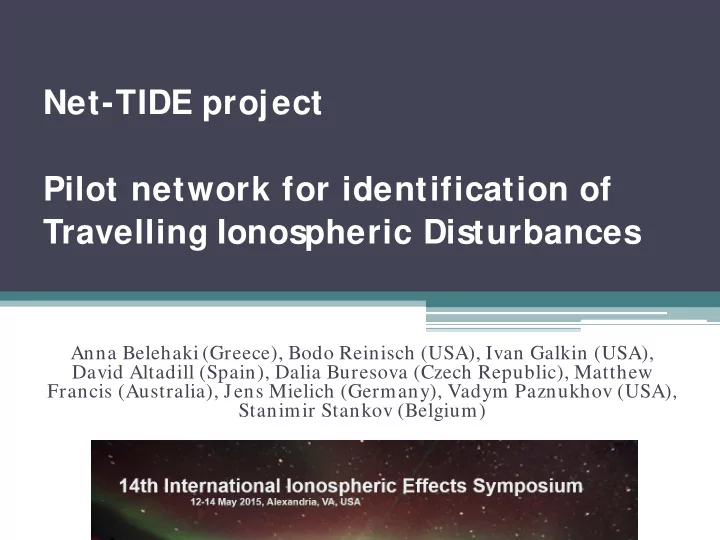

Net-TIDE project Pilot network for identification of Travelling Ionospheric Disturbances Anna Belehaki (Greece), Bodo Reinisch (USA), Ivan Galkin (USA), David Altadill (Spain), Dalia Buresova (Czech Republic), Matthew Francis (Australia), Jens Mielich (Germany), Vadym Paznukhov (USA), Stanimir Stankov (Belgium)
Travelling Ionospheric Disturbances - TIDs Travelling Ionospheric Disturbances (TIDs) are the ionospheric signatures of atmospheric gravity waves. TIDs have various sources of excitations • natural : energy input from the auroral region, earthquakes, hurricanes, solar terminator, and others artificial : ionospheric modification experiments, nuclear explosions, and • other powerful blasts like industrial accidents Credit: NASA / J. Grobow sky
S ystems affected by TIDs TIDs affect all services that rely on predictable ionospheric radio wave propagation. The disturbance imposed in the ionosphere is usually measured with the TEC parameter (1 TECU=10 16 el/ m 2 ). • In general TIDs affect the HF propagation : ▫ The accuracy of HF transmitter geolocation, especially at short distances (HF/ DF is a radio wave direction finding technique) ▫ The over-the-horizon radars • Large scale ionospheric biases caused by TIDs affect: ▫ High precision differential GPS applications, requiring accuracy > 2TECU ▫ Single base RTK and network RTK positioning
Characteristics of TIDs • Large scale TIDs propagate with wavelengths of 10 0 0 - 30 0 0 km , velocity of 300 – 1000 m/ s and amplitudes up to 10 TECU. LSTIDs are associated with auroral and geomagnetic activity • Medium scale TIDs propagate with wavelength of 10 0 -30 0 km , velocity of 100m/ s and amplitude of 1 TEC, occasionally 10 TECU. MSTIDs are mostly associated with ionospheric coupling from below, no clear correlation with geomagnetic activity.
Past efforts to identify TIDs using the Total Electron Content from GPS receivers ▫ Algorithms for calculation of TEC and its mapping contain a number of assumptions. ▫ Redistributions of the ionization due to TID might be not be detected by TEC. ▫ The real-time analysis of high resolution TEC data is still a challenge. Ding et al., 2007, JGR Post-processing analysis can support the identification of TIDs after the event happened but not the tracking
HF and GPS Data Comparison from Paznukhov, 2015 • Ratio of responses on GPS and HF varies significantly • Note large GPS signature at 19:00 corresponds to relatively modest signature on HF; conversely, at 21:00 HF response exceeds GPS 6
What needs to be done? • The TEC TID identification approach is indirect and approximate, and a m ore direct and accurate system to identify and track TIDs in real-tim e must be developed. Based on the exploitation of real-time observations obtained from ionospheric sounders
S ounding Types D2D Skymaping Synchronous Ionogramming Oblique drift Vertical Ionogram and Oblique Ionogram VI+OI Dedicated Oblique Reception of Transmitters of Ionogram Opportunity (ToO)
The DPS 4D network in Europe Preliminary settings D2D skymaping DPS4D operated from partner institutes Syncronous VI+OI NEXION operated by AFWA
S ynchronized sounding VI+OI S an Vito -> Athens
D2D settings for the link Ebro -> Dourbes
D2D waterfall displays at Juliusruh listening to the 3.0 MHz transmissions from Pruhonice Disturbed Quiet During quiet conditions on the path between Pruhonice and Juliusruh (the right panel), the HF pulse arrives at an apparent range of 2x435 km, zenith of 33° and azimuth 192°. The left panel shows substantially multimodal propagation of signal during disturbed conditions at various angles of arrival and Doppler frequencies.
Frequency Angular S ounding (F AS ) Technique • The idea: Use bistatic (or vertical) HF measurements of trajectory signal parameter variations (AoA+Doppler) to determine TID parameters Measured signal parameters: e (t) elevation angle j (t) azimuthal angle f D (t) Doppler shift t (t) Signal delay (vert. sound.)
14 LOUI-Base: Lowell ObliqUe Incidence D2D Ionograms D2D S kymaps Beacons Ionogram- Skymap- Synthesized D2D Oblique TAV derived and TAV- ionograms records derived ionograms skymaps data (HR2006) (LOIA) records N ( h ), f oF2, etc. f D ( t ), ε ( t ), β ( t ) To DIDBase: mid-point ionosphere for IRTAM TID (time permitting) FAS base
15 TIDBase design • Reference time UT • Location of TID (lat, lon, altitude) • Location of Instruments • Input f D ( t ), ε ( t ), β ( t ) series and metadata ▫ Frequency and virtual range ▫ Uncertainty of input data ▫ SNR per point • Multiple records of derived sets of TIDBase ▫ Ω – TID wave period ▫ N – Amplitude of TID perturbation ▫ K – k-vector of TID wave propagation ▫ Φ – phase of TID wave • Uncertainty metrics • Metadata ▫ FAS and DFT2Sky versions ▫ Computation timestamp
Proj ect schedule First Year Kick off meeting: 21 Novem ber 20 14 First consortium meeting Network calibration – Establishment of bi static links – First results on TID identification Second Year Establishment of the TID DB and real-time analysis system Contacts with end-users – requirements collection Second consortium and users meeting Release of first warning system prototype Third Year Improving the functionality of the warning system Meeting with users for final assessment of the warning system Final release of the warning system : October 20 17
• Observing platforms DPS4D • Network operation • NOA will set up the warning The proj ect team system Observer – • Hardware and possible software application of know-how the method in • Training Japan • TID DB setup • Use of IPS historical DB for inter- hemisphere studies of TID propagation. • Links with IPS users for the specification of warning system specs
Thank you for your attention! The Net-TIDE project team
Extrema velocities of a TID train versus its index for surface nuclear explosions and volcano eruption (Fedorenko et al., JSWSC, 2013).
Geomagnetic storm in progress
Recommend
More recommend